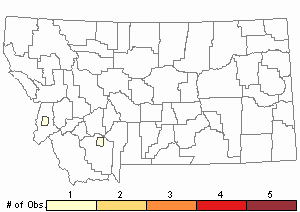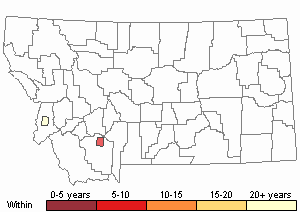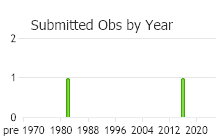View in other NatureServe Network Field Guides
NatureServe
Montana
Utah
Wyoming
Idaho
Wisconsin
British Columbia
South Carolina
Yukon
California
New York
An Orthotrichum Moss - Orthotrichum pylaisii
Native Species
Global Rank:
G4G5
State Rank:
SNR
(see State Rank Reason below)
Agency Status
USFWS:
USFS:
BLM:
External Links
State Rank Reason (see State Rank above)
One specimen was found in 1988 near Hamilton, MT on a dry cliff face. Verified as Orthotrichum pylaisii December 2015.
General Description
Plants: Acrocarpous. Up to 3 cm high, soft green, olive green (FNA 2014) or brown, growing in tufts (Crum 1981).
Leaves: Crowded, vertical, appressed and not much convoluted when dry, may spread when wet, 2-3 mm in length, ovate to lanceolate, keeled. Margins entire and rolled under nearly to the apex. Leaf apex widely acute, often acuminate (Crum 1981, FNA 2014). Costa strong, slightly subpercurrent. Perichaetial leaves similar to stem leaves (Crum 1981).
Leaf Cells: Distal and medial cells green, from elliptic to more rounded, having thickset walls and 1-4 simple or bifurcated papillae per cell. Basal cells thick-walled, hyaline, long linear, rectangular to sub-quadrate, may be shorter near margins (Crum 1981, FNA 2014).
Setae/Capsules: Setae 2-3 mm in length, straight. The slender pear-shaped capsules shortly exserted or emergent, 1.2-2.5 mm in length, slightly 8-ribbed, narrowed a little at mouth and neck when dry. The 16 exostome teeth may be slightly united below in pairs, have small holes from middle to the tips, are densely covered with papillae, and become reflexed with age. Eight endostome segments may be well-developed and about half as long as the teeth, else are not fully developed, or are often missing (Crum 1981, FNA 2014).
Diagnostic Characteristics
Similar to O. affine, but O. pylaisii has slightly broader leaves, and longer setae (Crum 1981). Capsules mostly exserted in North American plants, sometimes emergent in European ones (FNA 2014).
Orthotrichum pylaisii intergrades with O. laevigatum, but O. laevigatum has exostome teeth upright rather than bent back and downward, and its endostome is mostly lacking in capsules with open lids rather than typically present in at least some capsules as in O. pylaisii (FNA 2014).
Range Comments
Greenland; Canada: AB, BC, MB, NL, NT, NU, QC, YT; USA: AK, CA, ID, MT, WA, WY; n Europe; n Asia (FNA 2014).
Observations in Montana Natural Heritage Program Database
Number of Observations: 2
(Click on the following maps and charts to see full sized version)
Map Help and Descriptions
Relative Density

Recency



 (Observations spanning multiple months or years are excluded from time charts)
(Observations spanning multiple months or years are excluded from time charts)
Habitat
On rocks in alpine zone of mountainous North America or in Arctic, often on rocks used by roosting birds, seldom on Alnus or Salix trees or on bone; on granite in evergreen forests. Also on dry, unprotected cliffs and rocks near the sea (Crum 1981, FNA 2014). Found in wide range of elevations, about 325 – 9800 feet (FNA 2014).
Reproductive Characteristics
Gonioautoicous (FNA 2014).
Stewardship Responsibility
References
- Literature Cited AboveLegend:
 View Online Publication
View Online Publication Crum, H.A. and L.E. Anderson. 1981. Mosses of Eastern North America. 2 volumes. Columbia University Press, New York. 1328 pp.
Crum, H.A. and L.E. Anderson. 1981. Mosses of Eastern North America. 2 volumes. Columbia University Press, New York. 1328 pp. Elliott, J.C. and A.K. Pipp. 2018. A Checklist of Montana Mosses (1880-2018). Updated 3 January, 2020. Montana Natural Heritage Program, Helena, Montana. 73 pp.
Elliott, J.C. and A.K. Pipp. 2018. A Checklist of Montana Mosses (1880-2018). Updated 3 January, 2020. Montana Natural Heritage Program, Helena, Montana. 73 pp. Flora of North America Editorial Committee, eds. 2014. Flora of North America North of Mexico. Volume 28. Bryophytes: Mosses, Part 2. Oxford University Press, Inc., NY. xxi + 702 pp.
Flora of North America Editorial Committee, eds. 2014. Flora of North America North of Mexico. Volume 28. Bryophytes: Mosses, Part 2. Oxford University Press, Inc., NY. xxi + 702 pp.
- Additional ReferencesLegend:
 View Online Publication
View Online Publication
Do you know of a citation we're missing? Elliot, J. C. 1993. Second checklist of Montana mosses. Unpublished report. U.S. Forest Service, Region 1. Missoula, MT. 45 pp.
Elliot, J. C. 1993. Second checklist of Montana mosses. Unpublished report. U.S. Forest Service, Region 1. Missoula, MT. 45 pp.
- Web Search Engines for Articles on "An Orthotrichum Moss"





